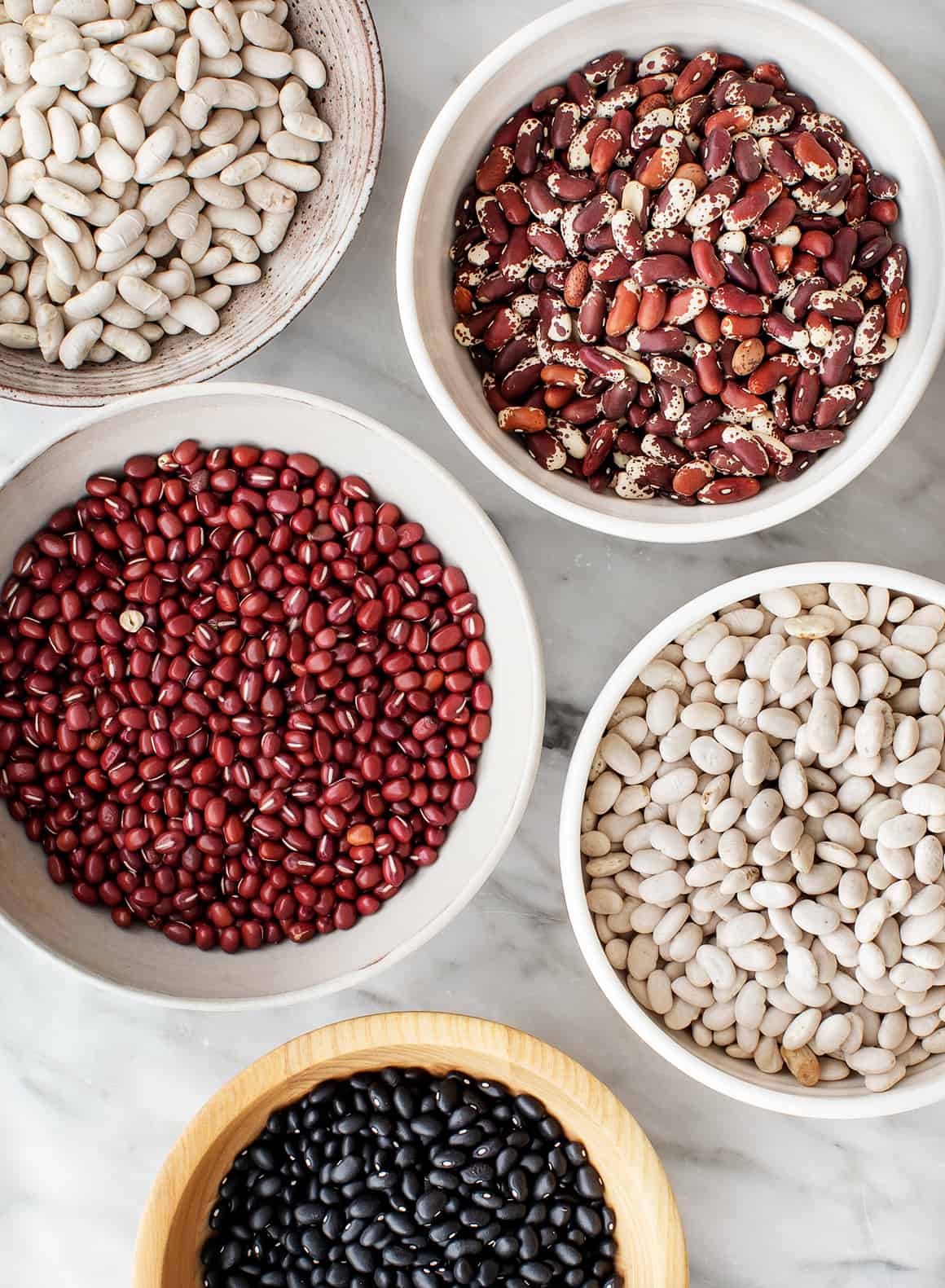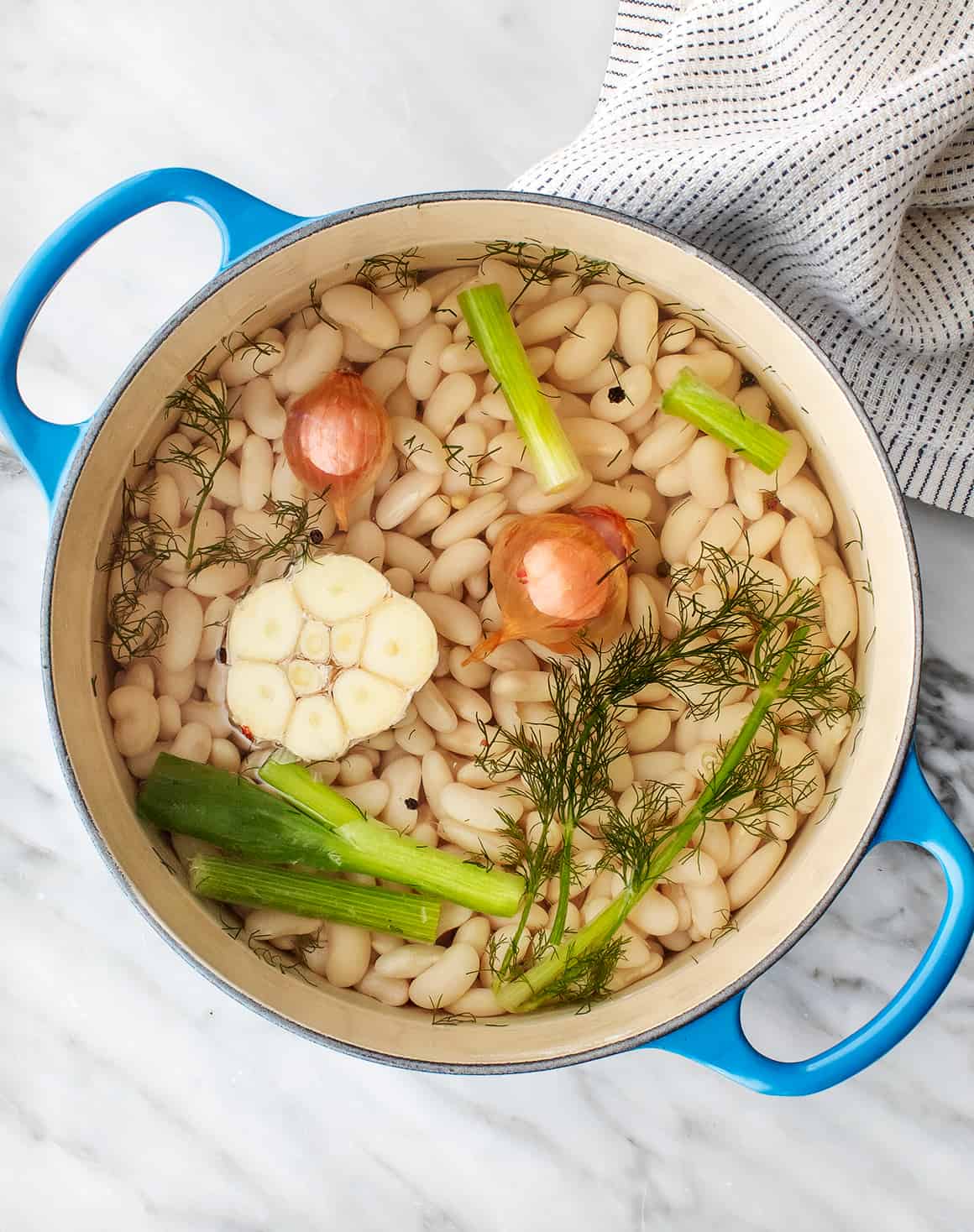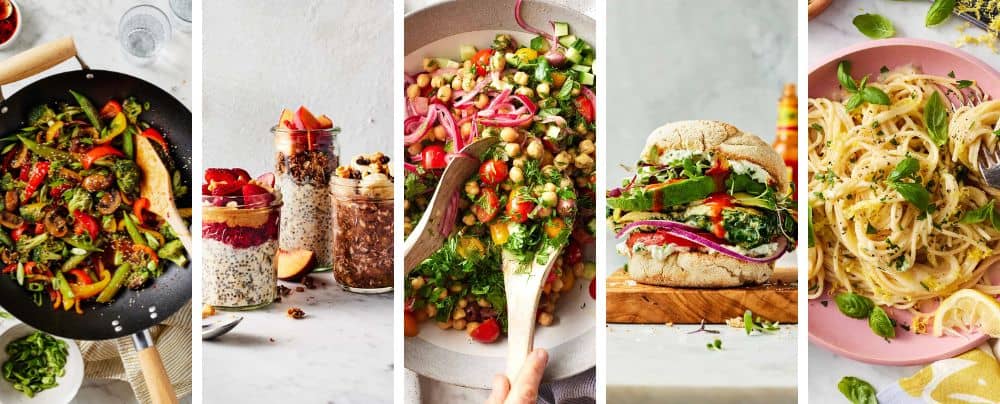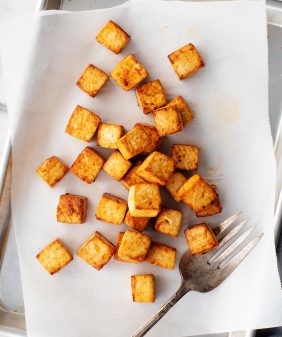Once you know how to cook dried beans, you'll always have them on hand. They're cheap, nutritious, easy to make, and - most importantly - delicious!

Canned beans are convenient, but in terms of affordability, taste, and texture, dried beans have them beat. If you’ve never cooked dried beans before, don’t let it intimidate you! My method for how to cook beans is an easy, hands-off process with a huge payoff. They come out soft and creamy, with a rich, aromatic broth surrounding them. Hot from the stove with a ladle of cooking liquid, they’re good enough to enjoy as a meal on their own!
Of course, you can also use dried beans anytime you’d use canned – in bowls, soups, tacos, and more. Cook a big batch and freeze them to have on hand. Trust me, you’ll thank yourself later!

How to Cook Beans
Cooking dried beans is easy! Here’s what you need to do:
- Pick them over. Small stones or debris are often mixed in with dried beans, so sift through the beans before you cook them. Discard this debris along with any shriveled or discolored beans.
- To soak, or not to soak? I highly recommend soaking your beans before you cook them. They’ll be ready in a fraction of the time, and they’ll be much easier to digest. To do this, place the dried beans in a large bowl and add water to cover them by 2 to 3 inches. Discard any beans that float. Then, leave the beans to soak for at least 8 hours, or overnight. In the morning, drain and rinse the soaked beans.
- Time to cook! Transfer the soaked beans to a large pot and cover them with 2 inches of water. If you’re using unsoaked beans, rinse them in a fine mesh strainer before you add them to the pot. Bring the water to a gentle boil, reduce the heat, and simmer for 30 minutes, discarding any foam that rises to the surface.
- Add seasonings & continue cooking. When the beans have simmered for 30 minutes, season them with salt. Continue cooking until the beans are tender, adding more water if they begin to look dry. The cooking time could be anywhere from 30 minutes to 2 hours more, depending on the size and freshness of your beans. I recommend checking them every 30 minutes.
When the beans are tender, season to taste and remove them from the heat. Store the beans in an airtight container in the fridge for up to 5 days, or freeze them for several months! And for the full recipe, see below.
Cooking Dried Beans – Exceptions
I use this method for cooking dried beans for almost every bean variety: black beans, pinto beans, cannellini, kidney, cranberry, and more. However, there are a few exceptions to the rule:
- Lentils. There’s no need to soak these legumes before you cook them! Each variety has a distinct texture and short cooking time – learn about cooking black, green, brown, and red lentils here.
- Split peas. Green and yellow split peas also cook quickly and don’t require soaking. Green split peas cook in about 25 minutes, while yellow split peas take 30-40 minutes. Both are great for soups, as they dissolve into a smooth, creamy puree as they cook.
- Adzuki beans. These little red beans have a delightful sweet, nutty flavor, and if you can get your hands on some, I highly recommend you give them a try! Simmer them for 35-40 minutes with salt and your desired aromatics (read more about these below!).

Seasoning Dried Beans
Dried beans cooked with sea salt and water are delicious, but adding an onion, garlic, or other aromatics to the pot will make them even more flavorful! These simple additions turn the starchy bean cooking liquid into a fragrant broth that’s just as tasty as the beans themselves. Here are a few of my favorite aromatics:
- A strip of kombu: This is optional, but it helps the beans become more digestible.
- Onions and garlic: Quartered onions, halved shallots, or smashed garlic cloves
- Herbs: A sprig of fresh rosemary or thyme, or sage, parsley, or cilantro leaves or stems. I often add frozen herbs to my home cooked beans.
- Spices: Black peppercorns, freshly ground black pepper, bay leaves, or dried chiles
- Vegetable scraps: Onion ends, fennel fronds, scallion tops, celery leaves, and more! I freeze these scraps for cooking beans or making homemade vegetable stock.
Add one or more aromatics when you add the salt, 30 minutes into the bean cooking process. When the beans are tender, remove and discard any add-ins before you eat. Let me know what variations you try!

More Pantry Basics
Loved learning how to cook beans? Try cooking one of these pantry staples next:
Then, find 30+ pantry-friendly recipes here!

How to Cook Beans
Ingredients
- 2 cups dried beans
- Water
- Sea salt
optional aromatics:
- Onion quarters, or halved shallots
- Garlic cloves, smashed or sliced
- Scrap veggies, like scallion tops, fennel fronds, herb stems
- Desired spices, like bay leaves, peppercorns
Instructions
For black beans, white beans, red beans, garbanzo beans:
- Place the beans in a large bowl. Discard any stones or debris. Cover with 2 to 3 inches of water and discard any beans that float. Soak at room temperature for 8 hours or over overnight. Drain and rinse well.
- Place the beans in a large pot and cover with 2 inches of water. Bring to a gentle boil. Reduce the heat and simmer, uncovered, for 30 minutes. Skim any foam off the top, then add 2 teaspoon sea salt and desired aromatics. Continue simmering until tender but not mushy, up to 2 more hours, stirring occasionally. The timing will depend on the type and freshness of your beans. I typically check them every 30 minutes. If they start to look dry, add a bit more water to the pot.
- When the beans are tender, discard the aromatics. Season to taste with more salt and pepper. Store cooked beans in the fridge for up to 5 days or freeze for several months.
For adzuki beans:
- Skip the soaking process. Rinse, then place the adzuki beans in a large pot. Cover with 2 to 3 inches of water and simmer for 30 to 45 minutes with desired aromatics and sea salt. Season to taste.
For split peas:
- Skip the soaking process. Rinse, then place 2 cups split peas in a large pot with 4 cups of water and 1/2 teaspoon sea salt. Bring to a boil, then reduce to a simmer, cover and cook until soft, 25 to 40 minutes. Season to taste. Split peas will become mushy in texture, similar to red lentils. They're great for thickening soups and stews.














I’m not a cook at all so this may seem like a dumb question but do you have to soak bean on the counter overnight? Can you soak them in fridge? I soaked them once on counter and they were all sprouted the next morning.
Hi Lacey, you can soak them in the fridge if you prefer!
Can you cook them in a crockpot rather than the stovetop? I would love to set and forget for a couple hours or so.
I think that would be fine!
I appreciate your method for cooking soaked white beans by checking every 30 mins for tenderness. Too often I have cooked them and they still seem too hard. I guess it’s the freshness of the dry white bean that you buy from the store which counts. If it is 2 hours for simmering….then that is what I will do, (if they do not come to the correct tenderness). I am cooking white beans tonight in a smoked ham broth which has crushed cloves, cinnamon sticks and the cooked and strained skin of a smoked ham joint and then adding them to a celery, carrot onion dry white wine, diced garlic and tomato based sauce. I have guests for lunch tomorrow… Thank you again!!!
Thanks for the inspiration! How do you get rid of the skin on the some of the beans, like pinto?? I watched some videos on deskinning them and it took me forever to do it!
Hi, there’s really no reason to remove the skins on pinto beans because they’re so soft. Some people like to remove the skins on chickpeas. I roll them with a paper towel, which helps loosen them a bit.
Id never waste my time. As when I cook beans I cook 10 cups of dried beans, puruenos. Which I know are fresh as we grow them in our almond orchards. I soak for 24 hours changing the water at least 4 times. That and simmering them for me about 2 hours tops. I also add, 10 cloves of garlic 2 medium sized onions yellow,whites, and 4-6 bay leaves mine were small. Followed by sea salt about 3 tablespoons spoons around the hour mark. Super delicious. I make this every 2 weeks. I store them in freezer bags for a quick cheap meal of enfrijoladas, bean and cheese quesadillas,tacos. I lay them flat so they store better and defrost quickly. Hope some one trys this.
Great info. on cooking and storing beans.
The cooking water smells good, can one use after cooking the beans, in a soup or any other dish – or should it be discarded ?
Hi,
I appreciate the information when it comes to cooking beans. Do you add the kombu right when you start cooking the beans, or do you wait 30 minutes like you do with anything else you add?
I add it at the beginning with everything else.
Last tip for tonite: I read this in a book decades ago, and have used it hundreds of times: To cook beans w/o soaking first get liquid (H2O) in the pot going at a rolling boil rate. Add beans very slowly w/o losing the ‘boil’. Continue boiling @ a slow boil for 3-5 min. Turn heat down and simmer until tender
Cooked a pot of pinto beans in 2 hrs the other nite. Be sure to thoroughly rinse the dry beans…